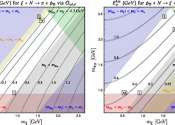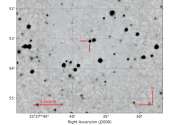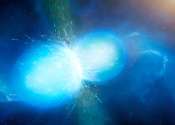Last update:
Astronomy news

Astronomers discover new open cluster with Gaia
Using ESA's Gaia satellite, astronomers have serendipitously discovered a new open cluster in the Milky Way galaxy. The newfound cluster, which received the designation Ash-1, is relatively young and consists of at least ...

Event Horizon Telescope makes highest-resolution black hole detections from Earth
The Event Horizon Telescope (EHT) Collaboration has conducted test observations achieving the highest resolution ever obtained from the surface of the Earth, by detecting light from the centers of distant galaxies at a frequency ...
Astronomy
3 hours ago
0
32

In six new rogue worlds, Webb Telescope finds more star birth clues
The James Webb Space Telescope has spotted six likely rogue worlds—objects with planetlike masses but untethered from any star's gravity—including the lightest ever identified with a dusty disk around it.
Astronomy
8 hours ago
0
131

Experiment sets new record in search for dark matter
Figuring out the nature of dark matter, the invisible substance that makes up most of the mass in our universe, is one of the greatest puzzles in physics. New results from the world's most sensitive dark matter detector, ...
Astronomy
22 hours ago
6
56

What makes a supercluster?
By eye, it's impossible to pick out the exact boundaries of the superclusters, which are among the largest structures in the universe. But that's because they are not defined by their edges, but by the common motion of their ...
Astronomy
23 hours ago
0
73

Researchers propose inexpensive 2.2-kilometer telescope that could make exoplanet movies
Can a kilometer-scale telescope help conduct more efficient science, and specifically for the field of optical interferometry? This is what a study recently posted to the preprint server arXiv hopes to address.
Astronomy
23 hours ago
0
70

Hubble captures unique ultraviolet view of a spectacular star cluster
Roughly 210,000 light-years away, the Small Magellanic Cloud (SMC) is one of our Milky Way galaxy's closest neighbors. In fact, this small galaxy is one of the Milky Way's "satellite" galaxies, which orbit our home spiral ...
Astronomy
Aug 26, 2024
0
37

Astrophysicists use AI to precisely calculate universe's 'settings'
The standard model of the universe relies on just six numbers. Using a new approach powered by artificial intelligence, researchers at the Flatiron Institute and their colleagues extracted information hidden in the distribution ...
Astronomy
Aug 26, 2024
0
174

New hyperluminous quasar discovered
An international team of astronomers reports the discovery of a new hyperluminous quasar. The newfound quasar, which received the designation eFEDSJ0828–0139, has a high star-formation rate and its black hole is accreting ...

Early galaxies not as massive as initially thought, study finds
When astronomers got their first glimpses of galaxies in the early universe from NASA's James Webb Space Telescope, they were expecting to find galactic pipsqueaks, but instead they found what appeared to be a bevy of Olympic ...
Astronomy
Aug 26, 2024
0
25

Novel features of r-process nucleosynthesis shed light on origin of heavy elements
In a study published in The Astrophysical Journal, scientists have proposed the features of the rapid neutron capture process (r-process) nucleosynthesis in a novel scenario: common envelop jet supernovae (CEJSNe). The study ...
Astronomy
Aug 26, 2024
0
44

Watch a star get destroyed by a supermassive black hole in the first simulation of its kind
Giant black holes in the centers of galaxies like our own Milky Way are known to occasionally munch on nearby stars.
Astronomy
Aug 24, 2024
0
37

Professor proposes how a black hole in orbit around a planet could be a sign of an advanced civilization
In 1971, English mathematical physicist and Nobel-prize winner Roger Penrose proposed how energy could be extracted from a rotating black hole. He argued that this could be done by building a harness around the black hole's ...
Astronomy
Aug 23, 2024
5
151

Hubble spots the Tucana Dwarf in the dark
A splatter of stars glows faintly at almost 3 million light-years away in this new image from NASA's Hubble Space Telescope. Known as the Tucana Dwarf for lying in the constellation Tucana, this dwarf galaxy contains a loose ...
Astronomy
Aug 23, 2024
0
23

Citizen science project identifies 20 new astronomical discoveries
A citizen science project, which invites members of the public to take part in identifying cosmic explosions, has already identified 20 new astronomical discoveries.
Astronomy
Aug 23, 2024
0
152

Astrophysical simulations predict new detectable gravitational wave source from collapsing stars
The death of a massive, rapidly spinning star can shake the universe. And the resulting ripples—known as gravitational waves—could be felt by instruments on Earth, according to new research published August 22 in The ...
Astronomy
Aug 22, 2024
0
69

Ancient duo of stars visiting from far reaches of the Milky Way discovered
An unusual pair of 10-billion-year-old stars, formed when the Milky Way was young, are visiting from the farthest reaches of the galaxy, researchers have discovered.
Astronomy
Aug 22, 2024
0
38

Astronomers explore the nature of galaxy NGC 891 with JWST
Using the James Webb Space Telescope (JWST), an international team of astronomers has observed a nearby spiral galaxy known as NGC 891. Results of the observational campaign, published August 15 on the preprint server arXiv, ...

The Wow! Signal deciphered—it was hydrogen all along, study says
In 1977, astronomers received a powerful, peculiar radio signal from the direction of the constellation Sagittarius. Its frequency was the same as neutral hydrogen, and astronomers had speculated that any ETIs attempting ...
Astronomy
Aug 21, 2024
0
53

MeerKAT observations detect a mysterious faint radio ring
An international team of astronomers reports a serendipitous discovery of a new radio ring toward the Galactic center. The newfound object is relatively faint and its true nature is yet unknown. The finding was reported in ...
Other news

Physicists predict existence of new exciton type

Study reveals new catalytic pathway for efficient water pollution control

Keeping native bees buzzing requires rethinking pest control

Studies provide key insights into chloroplast protein import system

Paper types ranked by likelihood of paper cuts

Geologists discover hidden magmatism at the Chang'e-6 lunar landing site































































